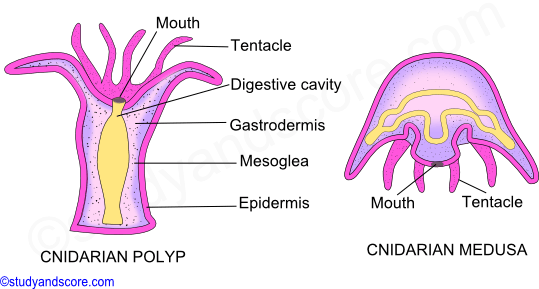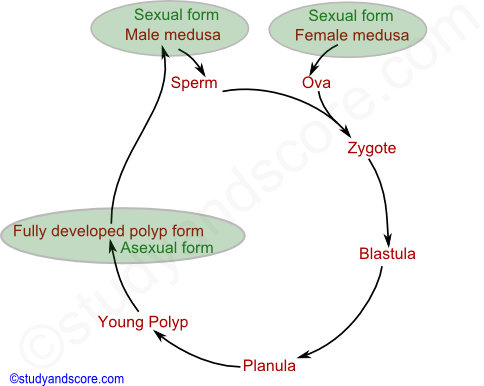Alternation of generation is also known as metagenesis. It is a phenomenon whereby, in the life history of an organism, a diploid asexual phase and a haploid sexual phase regularly alternate with each other. This type of true alternation of generation is present in plants like mosses and ferns. In mosses and ferns the asexual diploid saprophytic generation and sexual haploid gametophytic generation alternate regularly with each other. The diploid saprophytic plant produces haploid spores which develop into flat, green, heart shapes haploid gametophytes. Haploid gametophytes produce haploid ova and sperms. After fertilization, they give rise to a new diploid saprophyte. This completes one life cycle.
Similarly in Coelenterates, two types of individuals exist namely a polyp and a medusa,
Polyp: The tube like zooid is called polyp. The polyp reproduces asexually It is sessile and attaches to a substrate at the aboral end. It has a cylindrical body called the column. Its mouth is surrounded by food-gathering tentacles.
The body structure of polyp form is simple with simple muscles and nervous system. Velum is absent. Mouth is circular without oral lobes. Also its gastro vascular cavity is simple without radial circular canals. Sensory organs are absent in this form. This form reproduces asexually by budding.

Medusa: The umbrella like zooid is called medusa. The medusa is dioecious and free swimming. Its shape is like an inverted bowl. The tentacles hang from its margins. The mouth opening is centrally located at lower side. The medusa swims by medusa than in a polyp. It gives the medusa a jellylike appearance.
The body structure of medusa form is complicated with well-developed muscles and nervous system. Velum is present around the margins of the umbrella shaped body. Also its gastro vascular cavity is well-developed with radial and circular canals. Sensory organs called as statocysts are present on the margins of the tentacles. These forms reproduce sexually through gametes.
These two forms, polyp and medusa alternate successively where the polyp reproduce asexually to form a large number of medusa, each medusa reproduce sexually by the union of eggs and sperms to form zygote. The zygote grows into larva, which fix itself to a substrate and finally form a new polyp.
This alternation of generations is characteristic for class Hydrozoa. In class Scyphozoa the medusoid stage is dominant and the polypoid stage is very much reduced. In class Anthozoa the medusoid stage is absent and the polypoid stage has become the sexual generation.

In hydrozoans like Obelia, the life cycle includes two clearly defined phases or forms, a fixed polypoid phase also called as hydroid colony and a pelagic medusoid form. Hydroid colonies produce no gonads and reproduce asexually through budding to give rise to medusa forms. On the other hand medusa reproduces only by sexual method and produces ova and sperms. These ova and sperm in turn give rise to new hydroid colonies. This kind of alternation of generation in Cnidaria, in which an asexual polypoid generation appears to alternate regularly with a sexual medusoid generation is also known as metagenesis.
The following are the similarities between the polyp and medusa forms:
The following are the differences between the polyp and medusa forms:
| Polyp form | Medusa form |
|---|---|
| Fixed and rarely free form | Free swimming form |
| Body is cylindrical in shape and is elongated | Body is umbrella-shape |
| Base is attached to the substratum exposing the manubrium upwards | Base is always above hanging the manubrium downwards |
| Tentacles are usually 24 in number | 16 tentacles in young medusa & numerous in adult |
| Mesoglea is poorly developed | Mesoglea is well-developed |
| Velum is absent | Velum is present around the margin of the umbrella |
| Mouth is circular without oral lobes | Mouth is rectangular with oral lobes |
| Gastro vascular cavity is simple without radial and circular canals | Gastro vascular cavity is represented by stomach. It has 4 radial canals and one circular canal |
| Sense organs are absent | Sense organs called as statocysts are present at the margins of the tentacles |
| No gonads | 4 Gonads are present on the radial canals |
| Reproduces asexually by budding | Reproduces sexually by gametes |

- Share with your friends! -
Login to post your comment here...
- or with social Account -